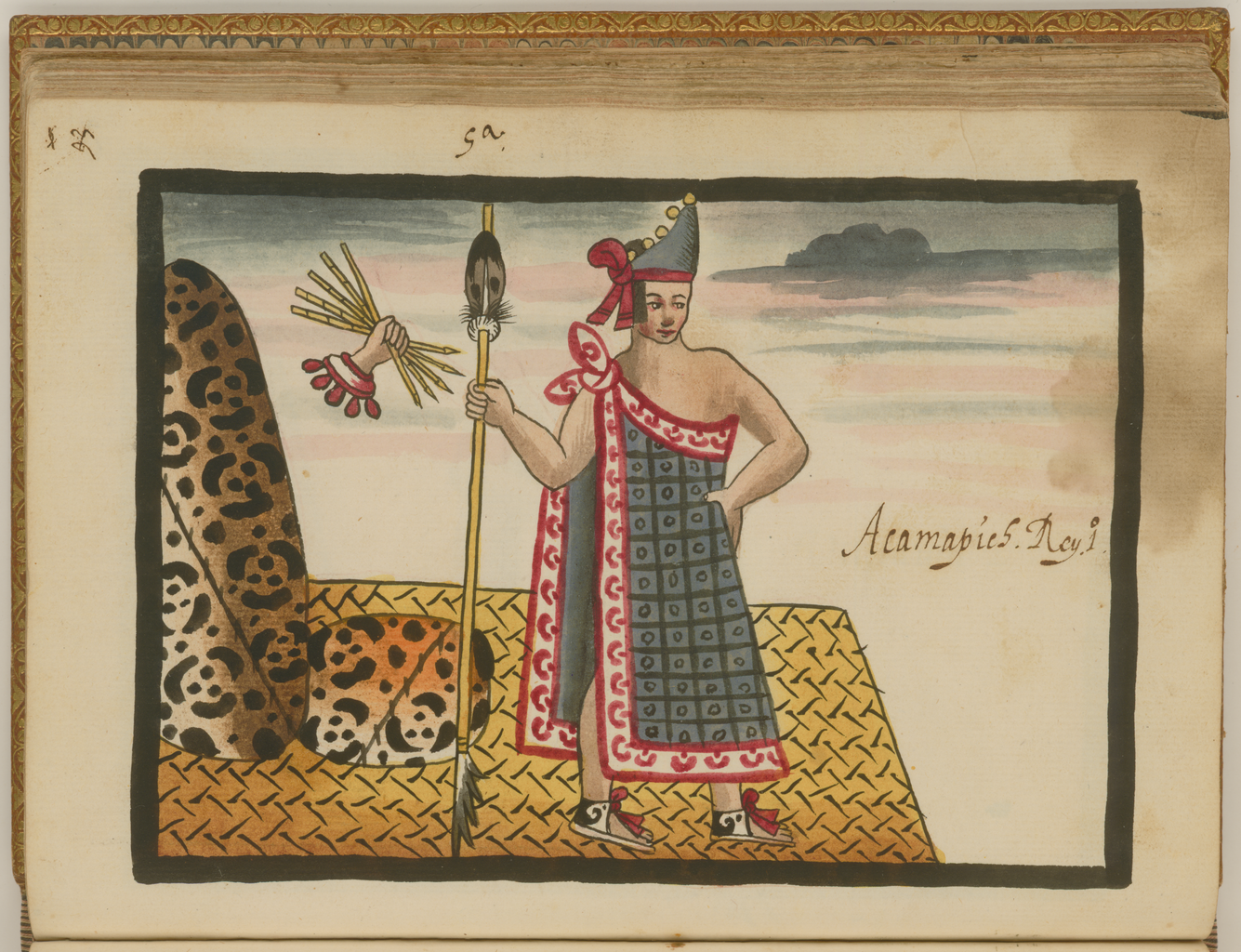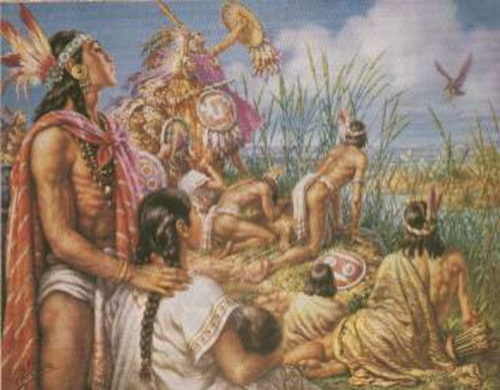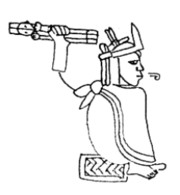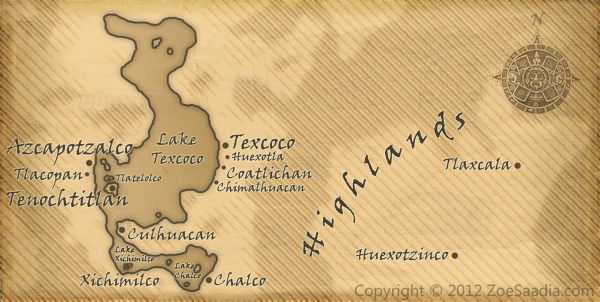The name Acamapichtli – Aca(tl)=reed, mapichtli=handful – meant ‘a handful of reeds’, sometimes depicted as arrows with blunted tips, has carved itself into Tenochtitlan’s history as one of the corner stones, or the true Tenochtitlan’s beginning.
He was the son of a prominent Mexica warrior who had married into a noble family of Culhuacan. Back in those times, the mid to the end of the 14th century, Culhuacan was still highly prestigious, imposing, influential altepetl (city-stated) located on the southern side of Lake Texcoco. Equal to the Tepanec Azcapotzalco in its dominance and influence, both altepetls were poised as a sort of friendly rivals, competing but not in a hostile way.

Still, for some reason, Acamapichtli wasn’t brought up in Culhuacan but rather grew up in either Texcoco or Coatlinchan, among Acolhua people who populated the eastern shores of the Great Lake. It is there, where Tenochtitlan’s elders, heads of various city districts and clans, came in their search for the legitimate ruler.
An imposing young man, with a list of achievements already behind him, added to such satisfactory lineage, Acamapichtli was offered the job, invited formally by Tenochtitlan founders’ council.
The year was 1376 or Ce Tecpatl-One Flint Knife by the Mexica Calendar count.
Arriving at his new realm, Acamapichtli, being a vigorous, dedicated, still relatively young man, got to work at once and with great enthusiasm. The island-city, more of a town back in these days, needed to be organized, regulated, invested, given sense of belonging and destiny, a project the young ruler, apparently, did not found repulsive or daunting.
Roads were stretched and paved all over the island, canals for easier transportation of goods in and out of the city dug, residential areas regulated, divided into more defined districts, extensive building projects commenced. Taking no break between this flurry of activity, he enacted new laws, regulating the growing altepetl’s life, putting it on the regional map with great determination. Everywhere around the island chinampas were spreading, the floating farms the lack of agricultural land dictated.

During the time of its first ruler’s reign, Tenochtitlan was of course nothing but a vassal of the powerful Tepanecs of Azcapotzalco. The tribute the Tepanec Capital demanded was high, sometimes even outrageous (one of the sources reports a one-time demand “… of a raft planted with all kinds of vegetables, along with a duck and a heron, both in the process of hatching their eggs…”).
The Tepanec Empire, expanding by leaps and bounds themselves, overshadowing Culhuacan and other regional powers rapidly, eyed the growing island-city with wariness. Tenochtitlan’s desire to have a ruler of noble blood – not the supreme ruler tlatoani but a governor, cihuacoatl – was met with reserved approval, and it did not decrease the amount of goods demanded to be send to Azcapotzalco with every new moon.
Hence the first ruler of Tenochtitlan was not a supreme ruler – Tlatoani or Revered Speaker – but just a governor, Cihuacoatl, an office that in the later-day Tenochtitlan would become the second most powerful position, equivalent to a Head Adviser.
It was only after seven years passed, in 1383 or Chikueyi Acatl-Eight Reed, with Azcapotzalco relaxing its watch and Acamapichtli doing nothing to provoke his city’s stern overlords, that he might have been anointed with the ultimate title of Tlatoani.
Sources like codex Mendoza state it most clearly, by two different glyphs (glyphs were the original Nahuatl writing system) depicting Acamapichtli’s changing statuses. In both glyphs he is depicted in a traditional way of Tenochtitlan rulers, sitting on a reed mat, wearing turquoise headpiece with a red back-tie, his mouth emits a speech scroll – a typical tlatoani, revered speaker’s, glyph.


But in the first drawing he is also crowned by a glyph of a snake with a woman’s head – cihuacoatl/governor symbol (cihua=woman, coatl=serpent), while in the later glyph he appears wearing a ‘pillar of stone’, a diadem of tlatoani, the supreme ruler.
In both glyphs his name is drawn most clearly by a drawing of hand grasping a bundle of arrows or reeds – Aca-mapichtli.
Well, being the first, his ascendance to the throne must have been rather sporadic, not through the customary way as with the later-day Tlatoanis.
So he did nothing to provoke Azcapotzalco into ruining the painfully maintained status-quo, while developing his island-city, biding his time, preparing for every eventuality.
Not allowed to campaign independently, the Mexica-Aztecs participated in the Tepanec wars with zest, pleasing their overlords and themselves. The spoils were not great, as most of it went to enrich Azcapotzalco, but the exercise must have been good for their spirits if not for their warriors’ prowess.

Still, while participating in raids on far removed places like Quahuacan and Chimalhuacan, venturing alongside their Tepanecs overlords into the fertile valleys of Quauhnahuac, Acamapichtli kept trying to gain at least semblance of independence, at least while raiding the neighboring southern chinampa zones of the Great Lake, namely Mixquic, Cuitlahuac and Xochimilco. It is unclear if he managed to gain the permission to do that or not, or even how successful he was raiding those contested areas, independently or not, because later all three were recorded to be re-conquered by Itzcoatl, the forth Tenochtitlan ruler.
All in all, Acamapichtli’s reign was reported to be peaceful and rewarding, a definite step on the path of Tenochtitlan’s future independence and glory.
It was during his reign that the city was divided into four neighborhoods or calpulli – Moyotlán in the southwest; Zoquipan in the southeast; Cuecopan in the northwest; and Atzacualco in the northeast. Houses of adobe and stone began replacing cane-and-reed dwellings. A great temple, teocalli was also constructed and many laws formed and enforced, even if partially.
To maintain the exalted blood of the future royal density, he had acquired a very exalted Culhuacan princess name Ilancueitl to be his Chief Wife. Yet, this woman, while being reported dutiful and good, bore him no children.
To correct that as much as to maintain closer ties with the city’s council of elders, heads of districts and other nobility, he had taken more wives, daughters of prominent men from each district. It is reported that he has as many as twenty wives, by whom he had sired many sons and daughters. The most prominent and well known, aside from his Culhuacan royal princess, was Tezcatlan Miyahuatzin, a daughter of the most prominent district’s leader and one of the ‘founding fathers’ of Tenochtitlan, Acacitli. This lady had mothered the next Tenochtitlan’s ruler, Huitzilihuitl. It is said that she lived in harmony with Ilancueitl, the Chief Wife.
Which isn’t to say that Acamapichtli did not fancy women outside his large collection of wives. Itzcoatl the forth Tenochtitlan’s tlatoani, was his son by a Tepanec slave woman, reported not to be the only son at that. This particular progeny was frowned upon, but not enough to prevent, at least, Itzcoatl’s climbing the social ladder right into the highest of offices a few decades later.
Acamapichtli’s reign ended in 1396 or Chikueyi Tecpatl-Eight Flint Knife with his death, a peaceful affair according to all sources. He has died of natural cases, not naming his successor, but leaving it to the council of the districts leaders to decide. Their choice fell on his son, Huitzilihuitl and it seems that it turned out to be a good decision on the part of the wise islanders bent on putting their altepetl on the regional map.
An excerpt from “The Jaguar Warrior”, Pre-Aztec Trilogy, book #2.
Acamapichtli sat upon his reed chair and watched the representatives of the four districts, all of them elderly men of great reputation, all related to him through this or that female relative.
To strengthen his ties with the city he had taken a wife from the most influential clans of each district, in addition to his pure-blooded Toltec Chief Wife. By now, he had fathered several heirs, but the most exalted of his wives had disappointingly borne him no sons.
He shrugged as it didn’t matter. The gods were mysterious, and she was still of childbearing age. A Toltec heir would fit perfectly on his father’s throne, would adhere to the rich legacy he intended to leave after him, but he has enough heirs as it was.
He listened absently as one of the elders complained about the water supplies in his district. The less appealing aspect of being a ruler was the necessity to listen to nonessential information that should have been making its way into his advisers care. However, this man was the leader of his district since before Acamapichtli had come to power, so he listened patiently and promised to take care of the problem.
Water, he thought as he strolled toward the terrace after the elders were gone. It could be wonderful to have it supplied from the springs on the mainland. The landscape around their shores inclining favorably, suggested a stone construction to run the water straight to the island’s pools and ponds. He would have to remember to talk to his engineers about it.
Bitterly, he snorted. What a dream. A futile, meaningless daydream. Azcapotzalco would never allow such construction; they would never stand it if Mexica people enjoyed fresh water. Had they only been able…
The thought about the Tepanec Capital brought the pressing problem of their delegation. He could not let them go, not yet. He signed to a slave who lingered nearby.
“Summon here Huacalli, the leader of the warriors,” he said.
The wild Tepanec, the leader of the delegation, he thought painfully. There must be a way to use him, to turn him into his emissary. Tenochtitlan’s people needed to raid the neighboring settlements independently. This matter had to be solved now that the southern shores of the Great Lake were weakened and ripe for conquest. His growing altepetl needed their floating farmlands.
That, and a foothold on the piece of the mainland. Otherwise it could not continue to grow. In that matter his time was running out, and the son of Azcapotzalco Emperor’s adviser might be a part of the solution.
He frowned. There was something about this young man, something that gave the Aztec ruler inkling. He needed to understand this man better. Accustomed to using people, his leader’s instincts told him that this hothead had more to him than he had cared to display; perhaps even to himself. There had to be a way to turn this one into a useful tool. The show of the cheerful troublemaker with not a thought in his head was just that – a show. For some reason this talented warrior had decided to waste his life on meaningless mischief. Why?
He narrowed his eyes against the glow of the setting sun. What had his Chief Wife told him about this man? He was a troublemaker at school, finally expelled from his calmecac. Then, he had made it into the elite warriors and stayed there, allegedly, with the help of his powerful father.
Ah, a powerful father, a great warrior, a Chief Warlord of many summers, the conqueror of Culhuacan. That could explain some things. How could a son compete against such a father? No, he could not, unless one was exceptionally gifted or exceptionally diligent, and the young Tepanec was neither.
I just wanted to say that I love the design of your website. Amazing!
Of course, the information is very important as well, but I can appreciate the design efforts put into this website!
Thank you very much, Efrain, for taking your time to spend on this site and for your wonderful feedback 🙂
I’m responsible for the contents of this website alone, but my web designer will be excited to hear what you said. Thank you 🙂
What a coincidence you and I have the same first name. I have been researching the Aztecs since sixth grade before the internet or interlibrary loan. I am working on a biography series on the topic. I am also doing a family tree on the rulers.
Very helpful info, also very neat website design